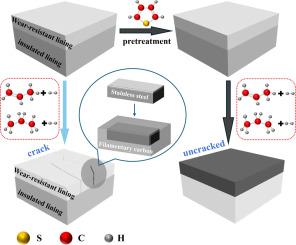通过对腐蚀的304不锈钢进行噻吩处理,延长反应器衬里的使用寿命
IF 6.3
3区 工程技术
Q1 ENGINEERING, CHEMICAL
Journal of the Taiwan Institute of Chemical Engineers
Pub Date : 2025-09-29
DOI:10.1016/j.jtice.2025.106430
引用次数: 0
摘要
衬里是化工加工设备的关键部件,其结构的稳定性直接决定着生产效率和产品质量。衬里结构损坏不仅大大增加了设备的维护成本,而且严重影响了企业的经济效益。因此,对衬砌破坏机理的研究和防护技术的开发具有重要的工程应用价值。方法采用刚玉-磷酸二氢铝体系制备衬里前驱体,包埋304不锈钢,经煅烧得到复合衬里。在C3H6/C3H8/H2混合气氛下对从制备的衬里中提取的不锈钢进行了评价。经气相噻吩处理后,提取的不锈钢样品在相同条件下进行对比测试。采用XRD、SEM、XPS、电化学等方法对不锈钢表面的腐蚀区域进行了系统分析。重要发现不锈钢钝化膜在衬里制作过程中被腐蚀,导致不锈钢表面形成Fe3O4, Fe3O4在高温下催化烃类气体转化为丝状碳。噻吩的引入可以毒害Fe3O4,降低其催化活性,防止丝状碳的形成,从而延长衬里的使用寿命。本文章由计算机程序翻译,如有差异,请以英文原文为准。

Extending reactor lining service life through thiophene treatment of corroded 304 stainless steel
Background
The lining was a critical component of chemical processing equipment, whose structural stability directly determined production efficiency and product quality. The lining structural damage not only significantly increased the maintenance costs of the equipment but also caused serious influence on the enterprise’s economic benefits. Therefore, research on lining failure mechanisms and protective technology development had the important value of engineering application.
Methods
The lining precursor was prepared using a corundum-aluminum dihydrogen phosphate system, with embedded 304 stainless steel that was calcined to obtain the composite lining. The stainless steel which was extracted from the prepared lining evaluated in a C3H6/C3H8/H2 mixed atmosphere. After gas-phase thiophene treatment of the prepared lining, the extracted stainless steel sample was tested under identical conditions for comparison. A systematic analysis on corroded zones of the stainless steel surface was conducted using XRD, SEM, XPS, and electrochemical measurements.
Significant Findings
The passive film of stainless steel was corroded during lining fabrication, leading to Fe3O4 formation on the stainless steel surface, which could catalyze hydrocarbon gases converted to filamentous carbon at high temperatures. The introduction of thiophene could poison Fe3O4, reduce its catalytic activity, prevent the formation of filamentous carbon, and thereby extend the service life of the lining.
求助全文
通过发布文献求助,成功后即可免费获取论文全文。
去求助
来源期刊
CiteScore
9.10
自引率
14.00%
发文量
362
审稿时长
35 days
期刊介绍:
Journal of the Taiwan Institute of Chemical Engineers (formerly known as Journal of the Chinese Institute of Chemical Engineers) publishes original works, from fundamental principles to practical applications, in the broad field of chemical engineering with special focus on three aspects: Chemical and Biomolecular Science and Technology, Energy and Environmental Science and Technology, and Materials Science and Technology. Authors should choose for their manuscript an appropriate aspect section and a few related classifications when submitting to the journal online.

 求助内容:
求助内容: 应助结果提醒方式:
应助结果提醒方式:


